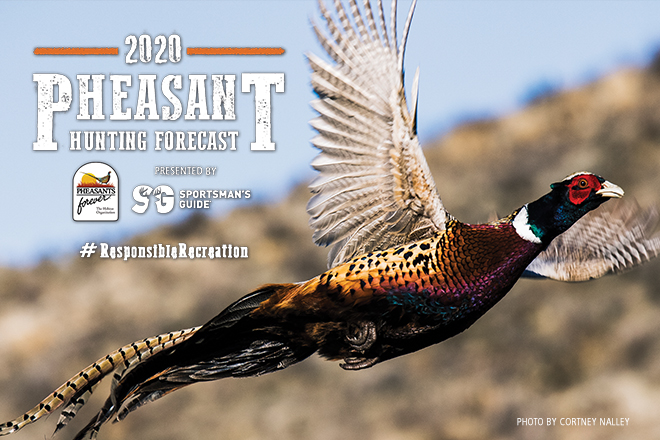
Excellent habitat and steady pheasant numbers provide reason for excitement heading into fall in the Buckeye State
By Andy Fondrick, Digital Marketing Specialist at Pheasants Forever
Editor’s Note: If you’re reading this forecast, you must hunt pheasants. If you hunt pheasants and don’t belong to Pheasants Forever or you need to renew, it’s time. Since inception, PF has impacted over 19 million acres of habitat, and created over 200,000 acres of permanently public wild places to hunt and recreate. Upland habitat, public lands and hunting heritage need you. Join, renew or extend and for a limited time get a sweet PF Field Hoodie to boot!
After a very wet 2019 that saw flooding throughout much of pheasant country, 2020 has provided much friendlier nesting and brood rearing conditions. Combine the favorable weather trends with the state’s most successful conservation program allowing for reenrollment, and pheasant hunters in Ohio have plenty of reason for excitement heading into fall.
WEATHER AND CONDITIONS
“The winter of 2019-20 was relatively mild,” says Joseph Lautenbach, wildlife biologist for the Ohio Department of Natural Resources (DNR). “There were a few weather events that brought extreme cold and snow; however, those events were relatively short in duration and likely had little impact on bird survival and they were likely in good condition going into the breeding season.”
Ohio’s spring conditions weren’t quite as mild, but they were drastically better than the year before.
“Spring brought some cold, winter-like weather events and even a little snow into May,” says Lautenbach. “This may have reduced nest survival; however, the cold weather occurred early enough in the nesting season that hens with failed nests likely attempted a second nest.”
Pheasants Forever and Quail Forever’s newly promoted Ohio State Coordinator, Cody Grasser, was excited about this year’s nesting season after the struggles of 2019.
“Thankfully, the relentless rainfall of spring and summer 2019 did not return”, Grasser says. “Conditions were better for nesting and brooding in Ohio.”
“It was a nice change of pace from the past few years where Ohio has experienced flooding throughout much of the pheasant range,” Lautenbach adds. “Pheasant brood survival is likely up due to the drier conditions.”
HABITAT, BROODS AND COUNTS
With upland habitat excelling and pheasant numbers holding strong, there is a buzz around the 2020 hunting season.
“Upland habitat on public wildlife areas looks excellent going into fall,” says Lautenbach. “Ohio Division of Wildlife staff members tasked with managing these areas have done an excellent job and reports from staff seem to indicate those areas experienced good reproduction.”
“In general, Ohio has seen a decrease in land enrolled in the Conservation Reserve Program (CRP). However, Ohio's most successful conservation program, the Scioto River Conservation Reserve Enhancement Program (CREP), was allowed to reenroll and sign new landowners up. This is great news for pheasants and pheasant hunters in Ohio.”
Grasser echoes the importance of the Scioto River CREP and the impact it has on roosters in the Buckeye State.
“Ohio's pheasant stronghold is in the central and southern parts of the state along the Scioto River watershed,” says Grasser. “The Scioto CREP plays a large part in supporting pheasants in this area through enrollment of private lands into the program to establish and maintain native grassland habitat. Management requirements in this program help ensure the habitat is of good quality to benefit wildlife.”
Grasser reports that Pheasants Forever & Quail Forever biologists have reported flushing adult birds and hearing cackling roosters while afield, while Lautenbach has the state survey reports to back up the field sightings.
“Ohio's spring crow counts indicated that the pheasant population is similar to last year,” says Lautenbach. “There have been reports of broods from our wildlife areas with wild pheasants and I have heard some nice reports of broods from landowners enrolled in the Scioto River CREP.”
He adds that while populations are down from peaks in past decades, there are still some pockets of excellent habitat that can yield a high-quality hunt.
TOP SPOTS
Both Lautenbach and Grasser recommend hitting the Scioto River corridor and checking out Ross, Pickaway, Madison and Fayette counties as good starting sports this fall. These counties should offer a combination of strong public land being managed by the Ohio Division of Wildlife and private land opportunities (be sure to obtain written permission from landowners).
Lautenbach also has a few specific wildlife areas you may want to drop a pin on.
“Visiting Deer Creek Wildlife Area and nearby Wildlife Production Areas in south-central Ohio can be very productive,” he says. “Big Island Wildlife Area in Marion County and Lake La Su An Wildlife Area in Williams County are both popular destinations for pheasant hunters in Ohio. Both wildlife areas provide large blocks of grass interspersed with wetlands and crops.”
Visit the
Ohio Division of Wildlife website to find public land hunting opportunities.
INSIDER TIP
So how would these two go about hunting longtails in Ohio this fall?
“Native grasses and early successional habitat attract a lot of birds, especially with a good food source within or nearby,” says Grasser. “Look to brushy fence rows and heavier cover when snow and colder temps arrive. Take your time and be thorough working through thick cover and you will find some birds.”
“Going during the week results in fewer hunters and can improve the quality of the hunt on public land,” says Lautenbach. “With a little bit of effort, folks can find less visited portions of the wildlife areas, even during the busy weekends. Another strategy to avoid crowds would be securing permission to hunt on private lands with CRP or CREP in central Ohio. While there are excellent opportunities on our wildlife areas and wildlife production areas, the private ground gets a lot less pressure.”
As a reminder, Ohio’s pheasant season runs from November 6 - January 10 and starting this fall the pheasant season no longer closes during the deer gun season, although hunters are required to where orange during that season.